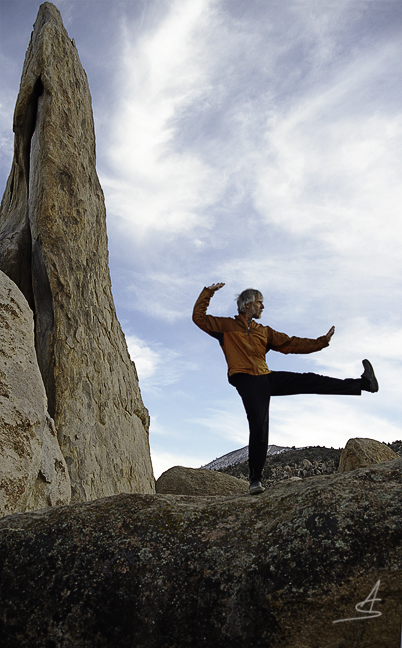Here is a case of holistic methods successfully treating an injured joint. Somehow I hurt my knee while simply playing catch to warm up my son, who is a high school pitcher. I’ve thrown baseballs a million times, but this time with each throw my left, landing leg hurt progressively more. I tried to baby it, but after 5 minutes I had to limp to get around. Then I batted grounders to him, and even as I tried to reassure myself that no injury had happened, the pain worsened and forced me to get off my feet. The next morning it still hurt badly and I had to face an unwelcome fact; something indeed had happened. It seemed like the bell had tolled, for me to go to an orthopedist, get “imaged,” and, gulp, accept the consequences. Or?
A guiding principle of T’ai-chi is to look toward the body center, and I knew that the next joint up from the knee, my hip, had been not operating smoothly for some years–likely the long-lingering effects of a serious 2001 accident to my lower spine. Also for some years I had been nursing a damaged achilles tendon on that leg, which I believe was the result of taking ciprofloxacin antibiotics. I pondered the fact that in regular activity, without a serious blow or twist, the knee is very unlikely to be the source of its own injury. While it might be the knee that was in pain, likely the injury came from ungainly transmissions of forces via those adjacent joints, and the knee is the strain point.
I called my friend Margy Verba, a former Pilates instructor who has moved on to master an avant-garde, gait-based analysis and therapy system. She emphasized that it is likely that a person of my many years, much less someone with my heavy activity mileage, has something amiss in the knee that a surgeon would find reason to operate on. But knee surgery wouldn’t change the way my adjacent joints worked, in fact immobility after surgery easily compounds problems. She suggested that I first visit her protégé, Jessi DeLong. Jessi is a Pilates and yoga instructor in Bishop who’s also trained in that gait-based system.

Jessi DeLong teaching at her studio
I limped into Jessi’s studio, and she took videos of me standing and walking as normally as I could. On her iPad I watched her analyze the subtle angles, movements, and non-movements in my train of stride, and in about 45 minutes she came up with a theory of what my body was doing and not-doing well. She took me through a set of exaggerated, “re-training” movements to do at home, sent me reminder videos of her doing them properly, and wished me luck.
In doing Jessi’s recommended movements, I noticed right away that it felt surprisingly “unnatural” in my lower back to turn a certain way while simultaneously lifting my arms, flexing my spine, sinking my hips, and weighting a foot. I wasn’t challenged with strenuousness or range, the movements just felt strangely unfamiliar. But this was a clue that Jessi had correctly found movement territory I was not accessing. I was subtly skewing my gait away from a healthy range of movement. I soon realized too that her seemingly complicated suggestions were all about sending healthy spiral action through the bones and joints, similar to what we work to do in T’ai-chi. Immediately after finishing her movement sequences I felt my stride travel subtly easier, slightly fuller and more balanced. Three days later my knee started feeling better.

Me doing “press the wrist” in the T’ai-chi form
Three weeks on now, my knee is pain-free, and I’ve even completed some pretty demanding mountain jaunts and lifted heavy loads in construction work. Jessi’s prescribed movements didn’t heal the knee, they re-trained my hip, spine, pelvis, ankle, foot and knee all to work better as a unit, absorbing and transferring forces better, and freeing the knee to heal. Obviously I didn’t have a serious injury, but probably a significant strain. Jessi graciously emphasizes that my T’ai-chi practice gives me an unusually “smart body,” more easily able to accept suggested new movements. And that’s the lesson: we are highly sophisticated and resilient mind-body systems with a billion ways good and not so good to carry out an intended action. And our subtlest movement habits can build strain and breakdown, or wellness and strength.


Hi Andy
Have you ever done any proper strength training beyond climbing/everyday life stuff? I ask this means to be a big factor in staying healthy the older we get.
Andy
I’m skeptical about too much strength training with weights, easy to create imbalances as well as an attitude to work hard against your body. I have at times enjoyed a lot of uphill running and classic “core” workouts. I’m a big advocate of yoga and I’m an instructor for T’ai-chi, practices to help create accurate and full range freedom of motion, and embed with the idea to find ways to make actions easier. I’ve also been introduced to Gary Ward’s Anatomy in Motion work. He’s a Brit with really innovative methods to analyze gait and restore easy coordination.